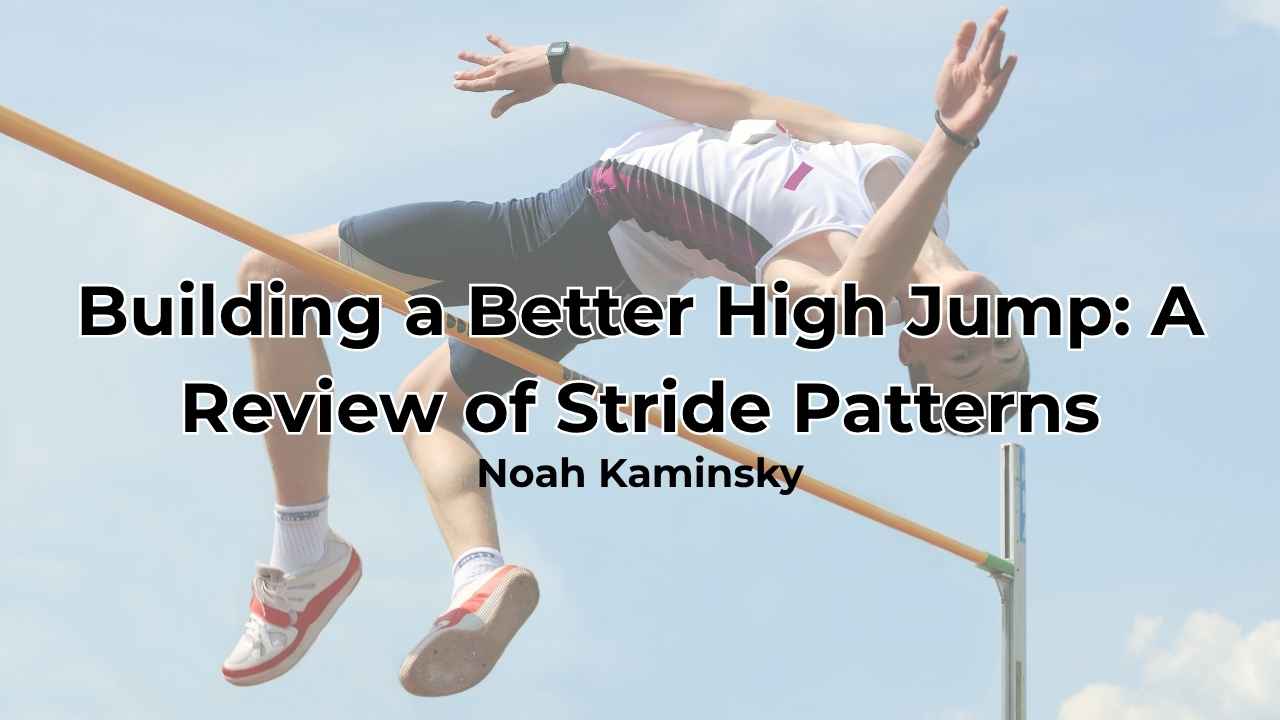From the soccer pitch to the football end zone, speed is one of the ultimate, game-breaking physical attributes. Sports are determined by inches at times, and speed is the measurement of an athlete’s time to cover a given distance. Increase this, and it gives athletes a competitive advantage no matter the event. Explosive plays change games and are fueled by speed.
In college football, speed is an extremely important commodity and is recruited accordingly. You understand how important speed is for success in field sports when you don’t have it! Fast athletes make big plays, as evidenced by nearly every SportsCenter “Top Ten.”
There are many misconceptions about training speed and power in the group setting. Whether application, principles, or modalities, it can be easy to lose sight of the forest through the trees. I created this article in the hope of clarifying eight of the major misconceptions that frequently pop up in conversations with coaches.
[adsanity align=’aligncenter’ id=9083]
1. Speed Is Everything in Field Sports
Speed is important, speed is a game-changer…but speed is not everything. The goal of training general athletic qualities is to increase the athlete’s ability to perform sport-specific movements with faster execution and increased proficiency. Sport-specific skill development will (and has to) rank higher than any general training ability. To be good at sports, you must train to be good at the sport.
Speed is important, speed is a game-changer…but speed is not EVERYTHING in field sports, says @CoachJoeyG. Share on XVideo 1. Sport-specific skill development must take a higher precedence in training once general athletic qualities increase to minimize negative transfer and interference effects. To be good at a specific sport, the skills required must rehearsed.
Deliberate practice of fine motor skills such as catching, throwing, dribbling, or any other specific skill will be the ultimate determination in technical ability in sports. Bridging the gap from general to specific will be based on the reinforcement of newly acquired increases in speed and power in sport movements. The goal, after all, is to be better at the sport.
2. More Speed Is Always Better
The only sport that runs uninterrupted in a straight line is track. All court and field-based sports require COD and deceleration. Negative speed, or deceleration, has major implications on the success of athletes in court and field sports. What’s the point of having a race car that can travel at 200 mph if it can’t put on the brakes? What makes many athletes special is their ability to manipulate speeds in rapid fashion. Barry Sanders could run full speed, stop his momentum instantly, and change his direction, making him almost impossible to track.
To achieve high levels of speed, athletes must accelerate. A definition for acceleration from Websters is: “… the rate of change of the velocity of an object with respect to time.” Understanding that the definition of acceleration doesn’t specify positive or negative, we can classify the ability to decelerate as negative acceleration and put it in the speed category.
In training, coaches spend countless hours fine-tuning acceleration angles and front side mechanics for increasing speed, but often neglect what McBurnie, Harper, Jones, and Dos’Santos coined “the ability to skillfully dissipate braking loads, develop mechanically robust musculoskeletal structures, and ensure frequent high-intensity horizontal exposure in order to accustom athletes to the potentially damaging effects of intense decelerations that athletes will frequently perform in competition.”1 As we design comprehensive training programs for field and court sports, we as coaches must attack deceleration training with the same vigor and focus that most put into acceleration and max velocity training.
As we design comprehensive training programs for field & court sports, we must attack deceleration training w/the same vigor and focus that we put into acceleration and max velocity training. Share on X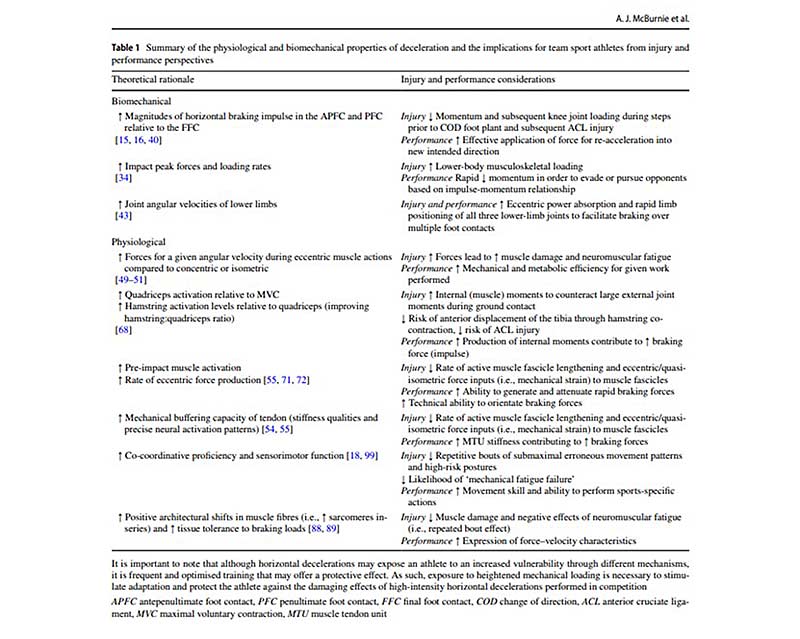
3. You Are Training “Plyometrics”
It has become common practice in strength and conditioning to label any jump activity as plyometric training—this has been going on since long before the fall of the Berlin Wall.
The clarification of what constitutes true plyometric training is well described in the book Supertraining2 by the Godfather of the exercise. Shock training is a “method of mechanical shock stimulation to force the muscle to produce as much tension as possible.”2 Defined, a plyometric action has “a sequential combination of eccentric (lengthening) and concentric (shortening) muscle action which was termed SSC.”3
Plyometric action and plyometric training are not interchangeable, as true plyometric training will differ from exercises that have plyometric actions by the shock and GCT of the event. The stretch-shortening cycle (SSC) drastically increase concentric work due to the rapid lengthening and shortening, which stimulates stretch reflexes (muscle spindles) and storage and reutilization of elastic energy in the muscle-tendon unit (MTU). The key word in all of this is rapid.
Plyometric action and plyometric training are not interchangeable, as true plyometric training will differ from exercises that have plyometric actions by the shock and GCT of the event, says @CoachJoeyG. Share on XPlyometric training comes in the commonly used forms of bounding, depth jumps, drop jumps, sprinting, and hurdle hops. If the movement has prolonged GCT, the exercise is now utilizing the contractile properties to generate power versus the utilization of the MTU through the SSC. In Supertraining, they termed the prolonged GCT version of these exercises “Powermetrics.”2

Plyometric (shock) exercises are meant to increase reactive ability and explosive-strength. The premise of this method is to create a stiffer spring, as stiffer springs are better at storing and returning energy. Box jumps, single-response vertical jumps, and rudimentary hops are not true plyometric training—even though they do contain prolonged elements of the stretch-shortening cycle—because the elastic energy stored in the elastic components will dissipate as heat after an extremely short time (hundredths of a second).
True plyometric exercises are suggested to contain GCTs less than 250 milliseconds4 as to maximize elastic properties of the MTU. Verkhoshansky and Siff go even further, stating “if the transition phase (or coupling phase) is prolonged by more than .15 seconds, the actions may be considered to constitute ordinary jumping and not classical training plyometrics.”2 So to train in this fashion, coaches should emphasize extremely fast GCT, and the exercise should appear jarring on ground contact.
Video 2. True plyometric training must keep GCT under 250 milliseconds to utilize the elastic energy generated in the rapid stretch to avoid the energy dissipating as heat.
4. You Are Training Speed Even If You Are Only Running up to 20 Yards
Vaccine has become a very popular word lately. In sports, it is imperative that coaches perform a needs analysis to understand the demands of the game and properly prepare the athletes for those demands. In many sports, a necessity for max velocity sprinting exists—if not trained, there is a potential for injury risk when exposed to these stresses in sport.
If this is the case in the majority of sports, why do some strength and conditioning coaches limit speed training to only 20 yards?
Acceleration is the rate in change of velocity. If an object has the potential to keep accelerating—but is cut short prior to terminal velocity—would that be considered adequate stimulus to vaccinate athletes against potential injuries associated with max velocity running? At 20 yards, a football player at the NFL combine is at roughly 90%-95% of maximal velocity.5
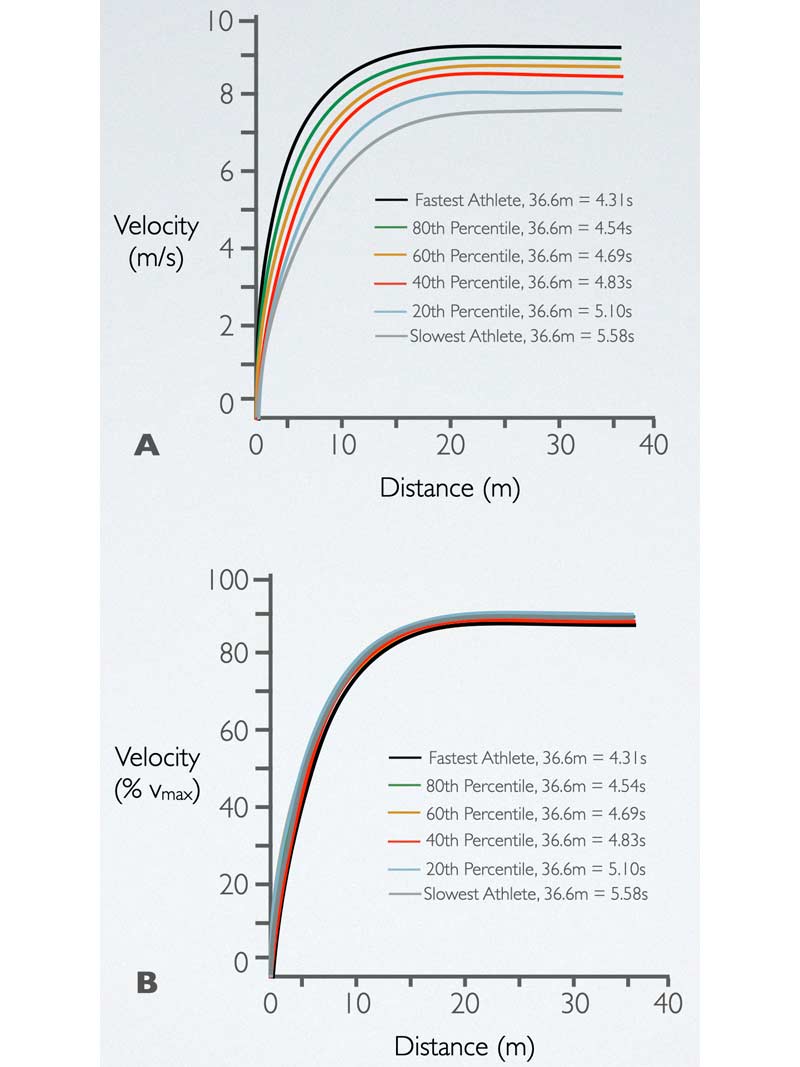
That leaves 5%-10% of their top speed untouched. This doesn’t sound like a huge difference, but let’s break it down.
- Athlete A has a top speed of 22 mph.
- 90% of 22 mph is 19.8 mph; round up and it’s 2 mph short of full-speed capabilities.
- 95% of 22 mph is 20.9 mph; round up and it’s 1 mph short of full-speed capabilities.
High-speed running training is not only necessary from a preparation standpoint, but it is critical from a performance standpoint—so, why avoid it? In the same study mentioned above5, Ken Clark hypothesized that an increase in maximal speed capabilities will increase the entire acceleration profile. As Tony Holler has stated repeatedly, this is the reason why “speed is the tide that lifts all ships.” The performance benefits of training above 95% of top speed include increased rate of force development (RFD), increased reactive ability, increased inter-muscle coordination, and increased intra-muscle coordination.
The performance benefits of training above 95% of top speed include increased rate of force development (RFD), reactive ability, inter-muscle coordination, and intra-muscle coordination. Share on XAnother benefit is seen in running economy and speed reserve. If an athlete increases their max speed (say by 1 mph), it has dramatic effects on that athlete’s ability to maintain higher velocities under fatigue.
- Athlete A has top speed of 22 mph; when fatigued, athlete A can maintain 80% of top speed for a mph of 17.6.
- Athlete B has top speed of 20 mph; when fatigued, athlete B can maintain 80% of top speed for a mph of 16.
- Athlete A beats Athlete B in this situation.
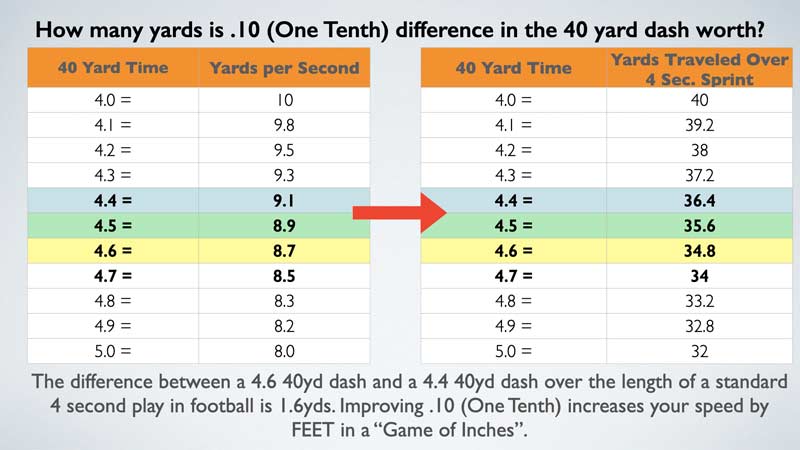
Training high-speed running not only increases terminal velocity but also trains the ability to hold higher running velocities longer, which I believe is a game-changer. It’s great an athlete can get to 20 mph, but how long can they hold it? If acceleration between two athletes is consistent but max velocity maintenance is different, one athlete will pull away even though the rate at which they got to that specific velocity was the same. Bottom line: If you are going to train speed, train all aspects of it.
Training high-speed running not only increases terminal velocity but also trains the ability to hold higher running velocities longer, which I believe is a game-changer, says @CoachJoeyG. Share on X5. High-Speed Running Will Prevent All Soft Tissue Injuries
There has been an emergence of research such as “Proximal Neuromuscular Control Protects Against Hamstring Injuries in Male Soccer Players: A Prospective Study With Electromyography Time-Series Analysis During Maximal Sprinting,”6 on the protective nature of high-speed running (HSR) for soft tissue injuries. High-speed running is a staple in my program for this specific reason (amongst others), but to say that it protects against all soft tissue injuries is naïve. HSR does increase reactive ability and overall tissue stress capacity, but it is specific to those stressors. Sports have change of direction and deceleration, which at times have higher ground reaction forces than HSR. Vaccines only deter the disease they are made for.
High-speed deceleration training, along with COD training, increases an athlete’s robustness against soft tissue issues and works alongside high-speed running in the fight against soft tissue injuries. In a recently submitted article “Deceleration training in team sports: another potential ‘vaccine’ for sports related injury?” McBurnie and authors state “high intensity horizontal decelerations are performed frequently in team sports match play and possess unique biomechanical and physiological characteristics.”1 This means that as strength and conditioning coaches, we must provide solutions to problems. The first part of this is identifying problems. Understanding the sport being trained is not only necessary, but it is borderline irresponsible to not know the demands of the sport.
Integrating high-velocity decelerations into training increases tissue stress capacity in that flexed hip and knee position as that negative impulse is applied. Most hamstring injuries occur with the foot in front of the athlete’s center of mass followed by a rapid eccentric contraction. This sequence happens every deceleration, and the muscle can be strengthened in these positions with training. The best ability is availability, so keep your players off the sideline and train both deceleration and HSR.
Video 3. Training the technical demands of specific cuts and decelerations that an athlete will be exposed to frequently will act as a vaccine against some of the major injuries that occur in these movements.
6. Strength Is Not Important for Speed
Strength is defined as the “ability to exert force on an external resistance.” (Stone, 1993) Newton explained to us through his second law that a force must be applied to accelerate and change the velocity of an object to make it move. The total force to accelerate this object is known as an impulse.
To change velocity or the velocity of another object, an impulse is required—meaning that a force is required. More impulse means more total force, which also means greater change in velocity. Dan Cleather states in his book Force: “in order to improve our performance, we need to increase the amount of impulse that we apply during a movement.”
Getting stronger allows for higher levels of peak force, thus increasing impulse. Use the example of an athlete who increases lower body strength and obtains higher jump performance in a countermovement jump. The previous GCT would be similar, but the peak force and ground reaction forces would have increased due to the newly acquired strength. Strength is still, and will always be, important in the development of speed and power.
When you look at size, there needs to be a linear relationship with maximal force capabilities. The bigger the athlete, the more force necessary to move their own inertia (a fancy way of saying their body). If the adequate amount of force cannot not be applied due to inadequate levels of strength by the athlete, a slower, less explosive movement will ensue. Also, add in the fact that majority of field sports require some sort of collision—from a kinetic viewpoint, this increases the peak force demand because now the athlete is dealing with preserving their momentum while an outside force applies high negative impulses to them.
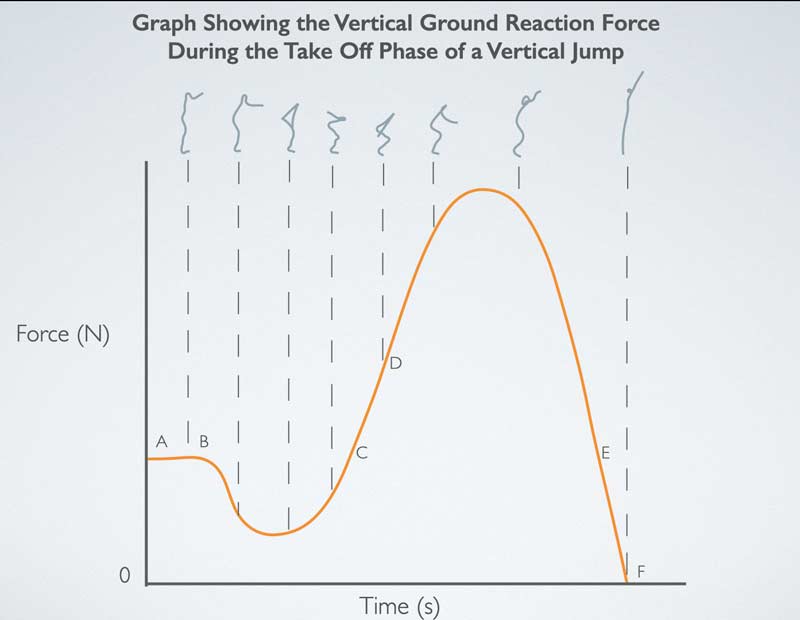
7. Sled Training Is Training Speed
Sled work is not speed work. It’s too slow, as 60% BW has shown decrements in speed by almost double. Yes, as the load decreases to around 10%, velocities are faster; still, these do not constitute true “speed work” because the ground contact times remain slower than normal acceleration GCT and rely on strength and power of the contractile properties and less on RFD and reactive ability. Depending on the load, sled training could be classified like concentric training in the weight room, as there is a direct correlation between load and velocity.
- <100% BW absolute strength
- 60%-100% BW accelerative strength
- 20%-60% BW strength speed
- 10%-20% BW speed strength
Video 4. Here is an example of an extremely strong athlete towing a 10% BW load and still seeing elongated GCT all the way through his first five steps of acceleration. The impulse needed to change the velocity of the athlete needs to be longer (GCT) to produce the force.
There are many ways to calculate the appropriate load for the desired stimulus a coach is trying to impose. JB Morin has a ton of research on how to force-velocity profile to get the proper load for the desired stress.
Let’s look at the reason the GCTs are elongated. To accelerate, the impulse applied must be greater than the inertia of the object that is increasing velocity. When a load is applied to an object, like a sled to an athlete, the mass of the object has increased, thus increasing the necessary amount of force to accelerate the new heavier object. To apply a more forceful impulse, which will increase the velocity of the sled, the duration of the impulse must be lengthened to develop the force necessary for acceleration. To increase the duration of the impulse, the athlete must push longer, leading to longer GCT.
This has been our practical experience here at FAU, through slo-mo video and Dartfish analysis: we saw with a 10% BW load on the sled that GCTs on the athlete’s third and fourth steps of acceleration were increased on average by 65% compared to the unloaded sprint.
[adsanity align=’aligncenter’ id=11130]
8. Sprinting Is Time-Consuming
Thirty-minute warm-ups and 15-minute rest periods: this is what many strength and conditioning coaches imagine as they contemplate programming speed sessions.
In a team setting, with sometimes up to 100+ athletes in one session, this seems like an unachievable task. The reason I believe that some coaches don’t plan speed sessions is they think they are time-consuming. Twitter is a fantastic resource but can influence coaches into thinking that they need fancy equipment and extravagant exercise selection. You need 10 minutes to get warm and enough space to run. Running fast is what gets you fast.
The reason I believe that some coaches don’t plan speed sessions is they think they are time-consuming. You need 10 minutes to get warm and enough space to run. Running fast is what gets you fast. Share on XHaving timing gates and 10 different sleds is fun and a plus, but people have gotten fast without any equipment. Some people didn’t even have shoes to train in and still managed to get fast. Understanding the prescription of sprint distances and total yard accumulation is necessary to make sure the athletes aren’t biting off more than they can chew. Knowing that, on average for team sports, the minimal effective dose for sprinting is around 90 yards will also put this misconception to rest. Sprinting can be done in a timely fashion with a lot of athletes at one time.
What’s the alternative—your athletes don’t sprint and lose out on all the benefits that occur when sprinting is trained?
Lead image by Aaron Gilbert/Icon Sportswire.
Since you’re here…
…we have a small favor to ask. More people are reading SimpliFaster than ever, and each week we bring you compelling content from coaches, sport scientists, and physiotherapists who are devoted to building better athletes. Please take a moment to share the articles on social media, engage the authors with questions and comments below, and link to articles when appropriate if you have a blog or participate on forums of related topics. — SF
References;
1. McBurnie AJ, Harper DJ, Jones PA, and Dos’Santos T.“Deceleration Training in Team Sports: Another Potential ‘Vaccine’ for Sports-Related Injury?” Sports Medicine. October 2021.
2. Verkhoshansky YV and Siff MC. Supertraining. 6th ed.; p. 268.
3. Cavanagh PR and Komi PV. “Electromechanical delay in human skeletal muscle under concentric and eccentric contractions.” European Journal of Applied Physiology and Occupational Physiology. 1979;42:159-163.
4. Walsh M, Arampatzis A, Schade F., and Brüggermann G-P. “The Effect of Drop Jump Starting Height and Contact Time on Power, Work Performed, and Moment of Force.” Journal of Strength and Conditioning Research. 2004;18(3):561-566.
5. Clark KP, Rieger RH, Bruno RF, and Stearne DJ. “The National Football League Combine 40-yd Dash: How Important is Maximum Velocity?” The Journal of Strength and Conditioning Research. 2019;33(6):1542-1550. doi: 10.1519/JSC.0000000000002081. PMID: 28658072.
6. Schuermans J, Danneels L, Van Tiggelen D, Palmans T, and Witvrouw E. “Proximal Neuromuscular Control Protects Against Hamstring Injuries in Male Soccer Players: A Prospective Study With Electromyography Time-Series Analysis During Maximal Sprinting.” American Journal of Sports Medicine. 2017;45(6):1315-1325. doi: 10.1177/0363546516687750. Epub 2017 Mar 1. PMID: 28263670.




